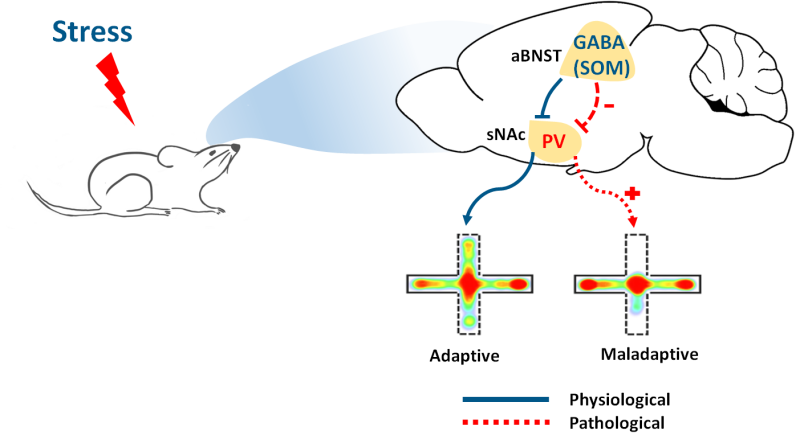Scientists Reveal Brain Circuit Mechanism under Anxiogenic Situations
Date:28-06-2020 | 【Print】 【close】
Stressors and stress responses are physical signs or symptoms, and natural occurring phenomena and chronic stress which results in an increased anxiety response.
In the past two decades, many rodent and human studies suggested that the bed nucleus of the stria terminalis (BNST) is a critical node in the stress response neurocircuitry.
Recent work on human drug addiction has also demonstrated a role of BNST in withdrawal-related anxiety and relapse, indicated an intrinsic link between this stress response region and the reward system. The nucleus accumbens (NAc) is a vital component in the reward circuitry, which responds to stress signals, and has a dominant effect on anxiety regulation.
Based on the findings that both BNST and NAc are engaged in stress-related disorders, like anxiety and addiction, it is reasonable to think that there may be interactions between these two regions.
Researchers from the Shenzhen Institutes of Advanced Technology (SIAT) of the Chinese Academy of Sciences revealed a previously undescribed circuit mechanism, precisely defined by the neuronal types involved, by which BNST modulated the NAc, which exerted a direct effect on anxiety state.
The study was published in Molecular Psychiatry (IF: 11.973), which is a top journal in the field of international psychiatry research and Nature Indexed journal as well.
By employing functional MRI signaling, GCaMP-based fiber photometry recording, genetically modified virus tracing and both optogenetic and chemogenetic neuronal manipulations, the results showed that in an anxious state, there was an increased functional connectivity between BNST and NAc.
Parvalbumin (PV) neurons within the NAc shell (sNAc) exhibited high excitability in a chronic stress mouse model that displayed excessive maladaptive avoidance during anxiogenic stimuli, and further, activation of these accumbal PV neurons promoted an avoidance coping response in healthy mice.
Moreover, a new GABAergic somatostatin (SOM) afferent from the anterior dorsal BNST (adBNST) was uncovered, which directly innervated sNAcPV neurons. Optogenetic activation of these GABAergic terminals in sNAc produced an anxiolytic effect, which was mediated by sNAcPV cells.
Inhibitory projections from adBNST attenuated sNAcPV neurons on the chronically stressed mice, and thus, activation of these inhibitory inputs from adBNST to sNAc rescued the excessively anxious state of the stressed mice.
"The results provided a potentially neurobiological basis for therapeutic interventions in pathological anxiety,” said Prof. TU Jie, “and may also help to explain why anxiety and addiction are highly comorbid, although these two common psychiatric disorders engage emotion and reward circuits, respectively.”
This study was supported by the platforms of Guangdong Provincial Key Laboratory of Brain Connectome and Behavior, CAS Key Laboratory of Brain Connectome and Manipulation, and Shenzhen-Hong Kong Institute of Brain Science-Shenzhen Fundamental Research Institutions, and funded by the National Natural Science Foundation of China, the Strategic Priority Research Program of Chinese Academy of Science (CAS), the International Big Science Program Cultivating Project of CAS, the External Cooperation Program of CAS, the Youth Innovation Promotion Association of CAS, the Guangdong Provincial Key S&T Program, Shenzhen Government Basic Research Grants and Shenzhen Discipline Construction Project for Neurobiology DRCSM.

A new GABAergic neuronal circuit from the BNST to NAc regulates anxiety-like behaviour (Image by SIAT)

Part of research group members. (Photo by SIAT)
Media Contact:
ZHANG Xiaomin
Email: xm.zhang@siat.ac.cn